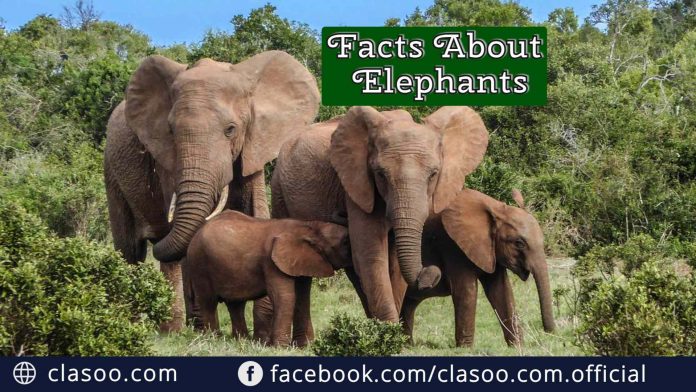
Children and adults crowd around an elephant whenever they see this magnificent animal and never get tired of watching it. Once a status symbol the elephant “OUR LOVABLE GIANT” is much a part of history, myths and culture for an Indian in general and a Keralite in particular.
Used to haul and handle huge logs of wood in timber yards, these great beasts are lovingly adorned with glittering decorations during religious festivities and other social events in Kerala, not known anywhere else in the world. As Kerala’s best-loved animals, elephants have always held a place of prestige in fables, folklore, legends, arts and crafts for centuries. We have given here some 100’s of Fun Facts about Elephant and hope it will be a great use to kids, students and adults.
Scientists believe predecessors of the present day elephants appeared on the earth around the end of the Mesozic Age and the beginning of the Cenozoic Age about 70 million years ago. Several species of this huge beast (namely Moeritherium, Dinotherium, Phiomia, Trilophodon, Amebelodon, Patybclodon, Cordillerion, Anancus, Mastodon & Mammoth) roamed many parts of the earth. Moeritherium, from which all other elephant forms evolved, resembled a pig and lived in ancient Egypt. The modern day elephants have evolved from the huge Mammoth. Out of the many species now only two genera with a single species each survive, the Asian (Indian) elephant and the African elephant. Unlike its larger and rarely tamed African big brother, the Indian elephant is smaller in size, graceful in looks and widely tamed. It is believed that for at ateast 3000 years these animals have been captured from the wild and tamed to serve man. Elephants are used for various tasks and as beasts of burden. Difficult to train African elephants remain largely wild while Indian elephants are bred in captivity too and many still inhabit the forests in India, Nepal, Sri Lanka, Burma and South East Asia.
According to Indian mythology, elephants were created at the request of the rishis (saints) in heaven. Those days the sun did not exist and the rishis approached Lord Brahma, the creator, to get a sun created for them. Taking a ball of mud in his hands Lord Brahma chanted vedic mantras and the mud ball turned into a shining sphere. He gave it to Aditi, a devadasi who swallowed it. After a period of 1000 years she delivered the sphere as it was but immediately it split into two. There emerged the glittering sun who rose up in the sky. (born of Aditi, the sun is also called Aditya in Sanskrit.)
Amazed; the rishis took both halves of the shell to Lord Brahma with a new request to create an animal they could play with and enjoy watching. From the half in his right hand he created “Airavatam” the bull elephant and from his left hand came “Abhramu” the cow elephant. Both these elephants were white-skinned, had four honey-coloured tusks and a pair of wings each. Brahma further created seven more pairs of elephants to guard the eight entrances to the heaven.
Soon these animals started creating havoc in the heaven with their mischievous pranks. Enraged the rishis cursed them to be sent to the earth. A pair of their tusks and their wings were also removed. It is believed that the elephants we see now are the descendants of those heavenly animals.
An elephant’s most fascinating organ is its trunk. Also termed proboscis, the trunk is the distinguishing physical feature of the elephant. The trunk is formed by the extension of the upperlip and acts as amazing nostrils. It is a nose but is like our hands too. It is used to breathe, pick up things and to drink (by sucking up water and shooting it into the mouth). The elephant takes bath by spraying water over in body using its trunk.
The elephant also uses its trunk to call to other elephants, drive away small enemies, make its shrill, piercing trumpeting sound, pick up smells etc. The trunk can be moved freely because there are no bones in it, only two types of muscles (longitudinal and circular). At the tip of the trunk is a finger- like projection (African elephants have two) which is used the way we use our fingers. If an elephant is hurt or frightened, others of the group gently touch it with their trunks to comfort it; the same way we humans do with our hands.
The trunk is amazingly sensitive to both smell and touch. An elephant can pick up a peanut or a huge log with equal dexterity. The trunk measures about six feet in length, weighs 300 kg and holds about six to eight litres of water in it at a time. Because of the important role the trunk plays the elephant takes great care of its trunk from injury. While sleeping the animal keeps the tip of the trunk in its mouth, so that no insects get into it.
Elephants grow slowly. Mother elephant carries the young inside her body for 20 to 22 months and normally gives birth to one calf. Twins are known but very rare. A calf when born weighs between 85 and 100kg. Height at the shoulder is less than one metre and the skin hairy. The trunk of the new born is only 10 to 15 inches long and not used to drink the mother’s milk: instead, it uses its mouth. The elephant mother calls her calf by slapping her ears against her head. In five years the young one becomes 2 metres high.
Asian Elephant
Elephas Maximus.
8 to 10ft.
2300 to 5400 kg.
only Males have tusks (in some cases even males have no tusks).
Only one finger like Projection at the tip of the trunk.
Only males undergo musth.
Widely tamed.
African Elephant
Loxodonta Africana
9 to 12 ft.
3600 to 6350 kg.
Males and Females have tusks.
Two finger like projections.
Both males & Females undergo musth.
Rarely tamed.
Elephants have very big molar teeth, no canines or lower incisors. The upper incisors form the tusks. During its life-time an elephant has six sets of molar teeth. Being a Voracious eater, its teeth wear out soon and new Sets replace the old. Later sets of teeth are larger than the earlier ones.
Though the presence of tusks is the best way to identify adult male Indian elephants, tusks may be absent in some cases. These tuskless males are called ‘Mukhnas’. However, mukhnas and females of the Indian species may have small rudimentary tusks termed ‘tushes’. On the other hand, both males and females of the African species have tusks. Tusks keep growing throughout an elephant’s life time.
An elephant cannot stretch its tongue like other animals.
Average body temperature of an elephant is 35.9°C. (96.6° F).
An elephant breathes 10 times per minute while standing and 5 times when lying down. Its heart beats 28 times per minute in standing position and rises to 35 as it lies down.
Allopathy is preferred to Ayurveda for treating sick elephants these days. It is more convenient as medicines can be injected into the animal. Medicines are injected into the veins of the elephant’s ears where the skin is less thick.
Elephants dislike bright sunlight and so during the hot season, keep to dense forests. They tolerate cold better than heat.
Elephant is a voracious eater and consumes about 300 kg of green fodder and drinks 150 to 200 litres of water per day: It drinks clean water only.
The elephant has a very keen sense of smell.
The hair of the elephant’s tail is said to have magical properties. If worn as a ring or bracelet it is believed to ward off evil.
Elephants are the best swimmers among land animals. They can swim in deep water continuously for about six hours.
Reference










![Popular Animals in the World [ Favorite Animals | Famous Animals ] Popular Animals in the World | Favorite Animals | Famous Animals](https://www.ewice.com/wp-content/uploads/2021/07/Popular-Animals-in-the-World-100x70.jpg)






